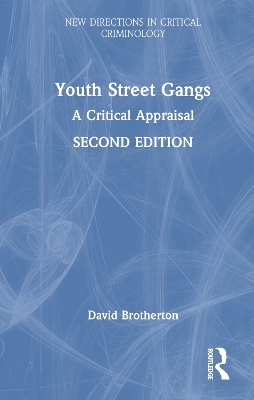
Youth Street Gangs
Routledge (Verlag)
978-1-032-69558-7 (ISBN)
- Noch nicht erschienen (ca. April 2025)
- Versandkostenfrei innerhalb Deutschlands
- Auch auf Rechnung
- Verfügbarkeit in der Filiale vor Ort prüfen
- Artikel merken
Gangs have been heavily pathologized in the last several decades. In comparison to the pioneering Chicago School's work on gangs in the 1920s we have moved away from a humanistic appraisal of and sensitivity toward the phenomenon and have allowed the gang to become a highly plastic folk devil outside of history. This pathologization of the gang has particularly negative consequences for democracy in an age of punishment, cruelty and coercive social control.
This is the central thesis of David Brotherton’s celebrated book on street gangs. Drawing on a wealth of highly acclaimed original research, Brotherton explores the socially layered practices of street gangs, including community movements, cultural projects and sites of social resistance. The book also critically reviews gang theory and the geographical trajectories of streets gangs from New York and Puerto Rico to Europe, the Caribbean and South America, as well as state-sponsored reactions and the enabling role of orthodox criminology. In opposition to the dominant gang discourses, Brotherton proposes the development of a critical studies approach to gangs and concludes by making a plea for researchers to engage the gang reflexively, paying attention to the contradictory agency of the gang and what gang members actually tell us.
The new edition has been revised and fully updated, containing three new chapters offering alternative approaches to interventions in gang violence, and to gang desistance, drawing on detailed interviews with Antonio Fernandez (King Tone), former head of the Latin Kings. The book is essential reading for academics and students involved in the study of juvenile delinquency, youth studies, deviance, gang studies and cultural criminology.
David C. Brotherton is Professor of Sociology at John Jay College and the Graduate Center, The City University of New York, USA.
Introduction, 1. Gangs and the Community: History from Below, 2. Divergent Gazes: From Humanism to Hobbesian Positivism and Social Reproduction, 3. Gangs and Situated Resistance: Agency, Structure, Culture and Politics, 4. Studying the Gang Critically, 5.Imagining Gangs: From Folk Devils to Objects of Desire, 6.Reflections From the Field, 7. The Need for a Critical Gang Studies, 8. Gang Interventionism (Part 1): Credible Messengers and the Neo-Liberal Imagination of Anti-violence Models, 9. Gang Interventionism (Part II): The Prison Life of Antonio Fernandez and the Making of a Gang Intervention, 10.Gang Interventionism (Part III): Gang Legalization in Ecuador, 11. Conclusion, 12. Appendix: Cultural Criminology and its Practices: A Dialogue Between the Theorist and the Street Researcher
| Erscheint lt. Verlag | 22.4.2025 |
|---|---|
| Reihe/Serie | New Directions in Critical Criminology |
| Zusatzinfo | 3 Tables, black and white; 22 Halftones, black and white; 22 Illustrations, black and white |
| Verlagsort | London |
| Sprache | englisch |
| Maße | 129 x 198 mm |
| Themenwelt | Recht / Steuern ► EU / Internationales Recht |
| Recht / Steuern ► Strafrecht ► Besonderes Strafrecht | |
| Recht / Steuern ► Strafrecht ► Kriminologie | |
| Sozialwissenschaften ► Soziologie | |
| ISBN-10 | 1-032-69558-7 / 1032695587 |
| ISBN-13 | 978-1-032-69558-7 / 9781032695587 |
| Zustand | Neuware |
| Haben Sie eine Frage zum Produkt? |
aus dem Bereich


